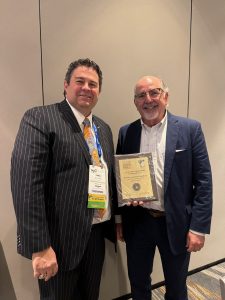Model focuses on optimal renewable energy zones
By ZOË WATKINS
zwatkins@bedordcountypost.com

Chris White, left, with Greg Vick, at the National Planning Conference on April 15. (Submitted photo)
Chris White, County Director of Planning and Zoning, was selected by the American Planning Association (APA) to receive the prestigious John Keller Merit Award for Planning Initiative with his design and development of the Bedford County Renewable Energy Overlay Zone Model.
This is the first time in Bedford County history, according to Commissioner Greg Vick, that the Planning Department has received a National Planning Award.
“I was pleased and honored to prepare and submit the application to the Small Town and Rural Planning Division of APA on behalf of Bedford County. I had the chance to speak with members of the committee who remarked the design of Director White’s was a ‘model they plan on sharing across the entire country,’” said Vick.
White told The Post, “Of course, I felt enormously grateful and honored to be recognized by the APA in that way. And let’s be fair, the APA doesn’t notice members like me without the support and confidence of the people who nominate you; the National organization has 40,000 members.
“A big thank you goes out to Commissioner Vick for his acknowledgement of confidence and his willingness to send in my nomination,” said White, who emphasized the high level of support he’s had from the county.
White received the award on April 15 at an awards ceremony held during the National Planning Conference (NPC-2024) in Minneapolis, Minn.
The Overlay Model
Essentially the “Overlay Model” is a way for rural communities, such as Shelbyville-Bedford County, to recognize the long-term benefits of renewable energy – in this case solar energy, according to White.
Put simply, the Overlay incentivizes renewable energy where it can provide the greatest benefit.
White explained it’s also a way to recognize that the residents have an obligation to preserve farmland for food security, important historical view sheds, and places where the government has invested in infrastructure for industrial development, especially as large renewable energy developments can be problematic.
“We don’t just need to preserve farmland for food security, we are obligated to preserve farmland for our cultural identity, especially in regard to our horse culture.
“The regulations in the Overlay Model do that very well and create a bifurcated process where a developer can choose one of two separate paths in their efforts to seek approval,” said White.
That is, if the developer’s project lies within the boundaries of the designated mapped zone, the department will incentivize the development by streamlining the approval processes.
In this case, “we’ve eliminated the requirement for rezoning, and we require less intensive buffering standards,” said White.
Or, if a developer chooses a site outside of that pre-decided zone – where the county has have already pre-determined that renewable energy projects could cause deeper hardships – the regulations require a rezoning of the land to a new zoning classification made part of the Overlay. This requires a public process and legislative action.
“In conjunction to that, the minimum development standards and buffering requirements for solar developments outside our mapped zone are far more intensive. In both paths, a consistent and very important list of base development standards must be met,” said White.
The county does not regulate residential solar applications. “We didn’t want to make it more difficult for people to augment their power bills with solar.
“The Overlay strictly focuses on Commercial and Non-Public renewable energy electric utilities,” said White.
The county also allows roof-top solar and solar fields on industrial buildings and property that solely benefit the specific industry.
But the financial incentives and tax benefits for solar and other renewable energy development have created huge demands for large rural tracts of land.
Chris explained that without a set of rules, two equally “bad” scenarios could occur.
“First, solar farms or other renewable energy solutions may not ever be allowed to develop anywhere. There are equal numbers of people out there who either praise them or diminish them,” said White. “Right now, we must rely on the published academic sources available to us.
“Second,” White continued, “communities may not regulate them at all, allowing them to completely gobble up enormous land resources before realizing that something must be done to preserve your identity and your diversity.”
A team effort
For this project, White said he studied the issues alongside the Planning Commission members, who are expected to provide policies that will both preserve the rural character of Bedford County as well as plan for job and housing growth.
“But we also work to find corrective paths from mistakes of our past and to imagine what Bedford County looks like with or without certain types of growth, transportation and mobility options, housing, flooding, land uses, etc.. There’s a lot to consider.”
White created something that would address the county’s needs, which he said were “pretty specific.”
“In other words, sometimes you are just trying to regulate a particular land-use with some basic ideas on why and how that land-use should be regulated from strictly an academic viewpoint. Yet sometimes, a particular land-use presents itself to you in a certain light, and you become hyper-focused on certain aspects of how that land-use will impact your community in a very specific way. As a result, you create perhaps a multi-tiered solution that is designed very specifically to answer very real and present circumstances,” he said.
This is how the Overlay Model came about. And what he won the award for is the third iteration of that process.
He explained, “I learned everything I could about solar energy projects in a short window of time, then created a basic set of rules.”
After further study, White amended the first version and asked the Board of Commissioners to pass its first amendment.
“Then lastly, upon receiving our first application for an actual solar farm, I was able to work directly with the developer in order to learn more, which provided me with a much deeper insight and perspective on the matter,” said White, referring to the Vanderbilt I Solar Farm located on Frank Martin Road.
“I used that opportunity to create the final piece of it. The final piece – and in my opinion, what makes our overlay so unique – is how we have bifurcated the process into two distinct lanes and how we asked our Commission to pre-decide the most acceptable areas in our County which would be the most accessible areas for solar developments. I don’t know of any other zoning scheme out there which has taken that approach,” said White.
White added that he has been contacted by several Tennessee jurisdictions about copying the plan, while the Tennessee Advisory Commission on Intergovernmental Relations (TACIR) published a report to the General Assembly which offered the county’s plan as a model that could effectively be used statewide.
“It’s all very surprising to me. I certainly never expected this much attention,” said White. “The management and support of our County Mayor allows me the opportunity to do exactly what I am hired to do which is to visualize what our county looks like 20 or even 50 years down the road. I also have tremendous support from our Planning Commission and chairperson.
“I and my team have been immensely supported in that mission. I personally hope the award will help instill some level of confidence that we do try very hard to protect our citizens and landowners everywhere we are lawfully allowed.”
Bedford County Mayor Chad Graham commented, “Bedford County is blessed to have such an outstanding Planning Director in Chris White. For Chris to receive the John Keller Merit Award for Planning Initiative simply validates his commitment to excellence and the value he brings to my administration.”
“I want to congratulate Director White and the entire planning staff as well as our Planning Commission, for this remarkable achievement.”



![For-Tips-and-Ideas-Phone-300x250-Bedford-County-Post[1]](https://www.bedfordcountypost.com/wp-content/uploads/2023/09/For-Tips-and-Ideas-Phone-300x250-Bedford-County-Post1-300x250.jpg)
![Subscribe-Now-300x250-Bedford-County-Post[1]](https://www.bedfordcountypost.com/wp-content/uploads/2023/09/Subscribe-Now-300x250-Bedford-County-Post1-300x250.jpg)

